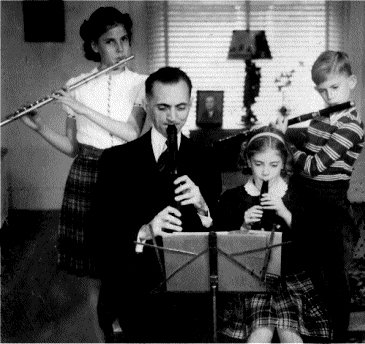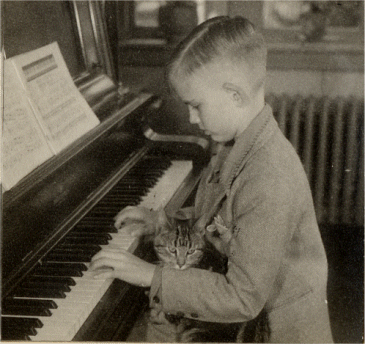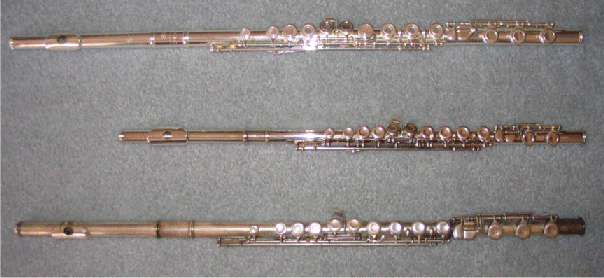|

|
My father taught my sisters, Edith and Ruth, and me to play the
flute when we were in grade school. I enjoyed playing but not practicing -
thus I never became proficient. I put it aside after high school but rediscovered
the joy of playing in November 2008. Now I practice but I am still not
proficient. There are three reasons for this page: (1) to let my friends
know what I am doing; (2) to let other would-be players know what I have
found that is fun to play; (3) to seek information on the Gemeinhardt flute my father bought for me in 1947.
|
The Formative Years
Edith is more interested in what is going on than in the music. Her flute
playing days were few; she became a majorette. I am playing a wooden D flute
which is still in the family. Dad is playing a recorder. His accomplishments
were many. He became superintendent of schools in Oklahoma City and later a
professor at the University of California. In his undergraduate days he and
his twin brother formed the freshman "Rat" band at the University
of Richmond. He played the flute and saxaphone.
Ruth is playing a small recorder. Her flute career did not last long either.
She and I did take piano lessons off and on during our school days. I was the
only one to practice while holding a cat.
Favorite Music to Play
Music published with play-along-CD:
Favorite Christmas Classics for Solo Singers, Alfred Publishing
Company
Not only are these wonderful songs (including two I had not been familiar
with, The Virgin's Slumber Song and In the Bleak Midwinter) but
there are separate pages for flute parts to Sheep May Safely Graze and
O Come, O Come, Emmanuel. Also, if you can get someone to sing or play
the melody, playing the accompaniment to O Holy Night and Ave Maria
is great fun. If you can't find someone live to play with you can find the
song on YouTube. The problem if finding the right key. Of course, you can
always play the accompaniment without the solo.
Play Grieg, De Haske Publications BV
Contains 14 pieces by Edvard Grieg with a CD having
the songs recorded both with and without the solo. Many of the numbers such
as In the Hall of the Mountain King are severly
edited but are still fun to play. Rigiadoon
is a lively dance with is particularily
challenging. I don't care for the arrangement of Morning (from the
Peer Gynt Suite) much prefering
the one in Flute Classical Favorites published by Hal Leonard.
March Melodies, Carl Fischer
I love playing marches, a carryover from high school band days. This is a
great selection including the expected Stars and Stripes Forever (with
the piccolo part). My favorite is Entry of the Gladiators which I hope
to play well some day. There are a few note errors
and one big error in the publication: the printed music is in a different key
from the recording for Old Comrades. So far, Mr. Fischer has not provided
an addenda.
Tchaikovsky's The Nutcracker, Cherry Lane Music Company
Some of these are a bit simpler and a bit shorter than I would like, but
still challenging for me.
Concert and Contest Collection, Compiled by H. Voxman,
published by Rubank, Inc.
Fourteen composition, ranging from advanced to the seemingly impossible (Flight
of the Bumblebee) - until I hear it played well by an eight-year old on
YouTube. I especially enjoy Andalouse by
Emile Pessard, Valse
Gracieuse by W. Popp, Polonaise by J. S.
Bach and Pan! by J. Donjon. Rubank publishes the piano accompaniment and a play-along
CD separately.
Music published without CD:
Selected Studies, by H. Voxman, published by
Rubank, Inc.
This is a book of advanced etudes, some very difficult and not necessarily
music I enjoy playing. But the compositions by Kohler are, for the most part,
beautiful and not impossible to play with a reasonable amout
of pratice. There is at least one etude in each key
(why does anyone want to play in F# major?).
Music from YouTube:
There is an incomprehensible number of music videos on YouTube with which one
can play along. If you don't have the printed music and can't (or don't want
to) play without the music there are videos which show the music along with
the sound. Canada's "flutegirl" has posted many fun tunes, for
example: The Entertainer by Scott Joplin, Cryin'
by Rob Orbison, Canon in D by
Pachelbel.
I have the music for Mozart's Allegro (Eine kleine Nachtmusik)
which I play along with the New Trinty Baroque
and Rondo alla Turca which I am
trying to learn playing along with a video by a sensational young pianist Aaron Kurz.
But the video on YouTube which I most enjoy playing along with is Chitty Chitty Bang Bang. Listning to this tune from the film of the same name
should bring a smile and get your toe tapping. (The original children's story
was written by Ian Fleming, the creator of 007 James Bond.) The video I play
with is a production number from the British reality show I'd Do Anything. It is from the
series used to select the Nancy and Oliver for what is proving to be a very
successful revival of Oliver!. Watch the video here: Laurence and others
performing Chitty Chitty Bang Bang.
If you like to sing rather than play, these are the words to Chitty Chitty Bang Bang. I
need help with a few words. The speed and British accent are too tough for
me.
I have composed a march, AVC
Fanfare March.
My flutes
The flute at top is the Eastman EFL320BOF I bought in December 2008. The
open holes are filled for the present. The tone is very nice. It seems that
the hard pads on the right hand keys cause excessive noise, at least compared
with the soft, quiet pads on the Gemeinhardt.
The middle flute is an Armstrong E-flat flute on loan from my nephew. It is
pitched three half-steps higher than the standared
C flute. The smaller diameter give a less rich tone.
I have no idea what the status of this type of flute is in the world of sophistaced flautists. It seems that it should be a
useful flute for younger players because it is easier to hold and, I believe,
requires slightly less wind. There could be a problem with limited printed
music.
The bottom flute is the Gemeinhardt my father
bought secondhand for me in 1947. I did not appreciate the instrument and did
not take proper care of it in my school days. But after having some pads
replaced it sounds great. Perhaps I should not have bought the Eastman. A
helpful employee of Anaheim Band Instruments suggested that this flute was
made under an agreement that Gemeinhart had with
Haynes. It is a closed-hole b-foot instrument, serial number 258 (A. Gemeinhart). Gemeinhart does
not list serial numbers for any flutes prior to 1957 on their web site and
the inference is that they have no desire in attempting to recreate a data
base for records which have been lost or destroyed. I am very interested if
anyone has information regarding this flute.
Back to Main
Page
Last
update: January 2, 2014
|




